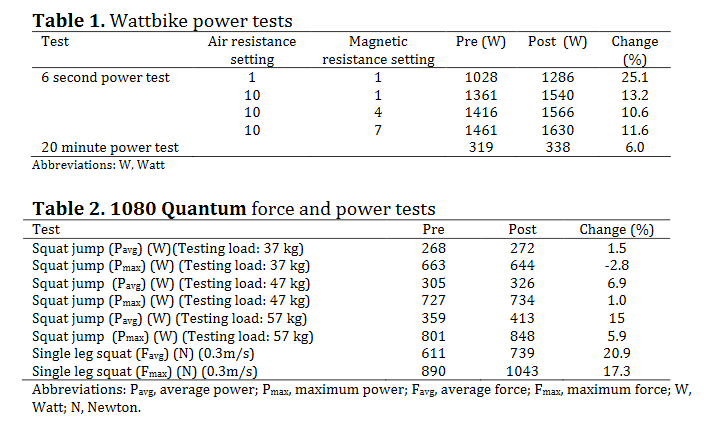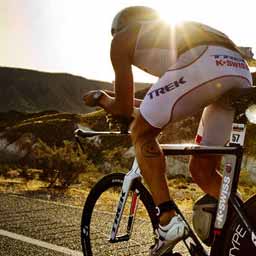THE EFFECT OF HEAVY STRENGTH TRAINING ON POWER DEVELOPMENT IN CYCLING – A CASE STUDY
Ghelem, A., Eriksrud, O., 1080 Motion AB, Stockholm, Sweden
BACKGROUND
Power and force output is important in cycling. It has been shown that adding heavy strength training improves performance in well-trained female cyclists (Vikmoen et al., 2015). The purpose of this case study was to look at the effect of heavy strength training in 1080 Quantum on power development in cycling in an elite male triathlete.
METHODS
Athlete (VT) (35 years, 88 kg) is a male triathlete performing at an international level age 35-39. VT wants to improve cycling performance, which was measured using Wattbike (Nottingham, UK). Wattbike has been found to be reliable and valid (Hopker, Myers, Jobson, Bruce, & Passfield, 2010). In the analysis tool, powerhub, information such as cadence, time, distance, peak and average and power as well as pedal technique is provided. VT performed max power tests (6 second duration) at different resistance settings (Table 1) and a 20 min test at self-selected resistance and cadence in order to maintain the highest average power during the test. Maximum power was recorded for the 6-second test, while average power was recorded for the 20-minute test. The 6-second power tests were done pre (08.09.2015) and post (29.09.2015) while the 20-minute power test was done pre (08.09.2016) and post (01.12.2015). No familiarization was done, since VT was already familiar with Wattbike. Based upon these results we wanted to improve cycling power.
VT was subsequently tested in maximum and average force in a single leg squat in using the isokinetic function with 1080 Quantum with a speed limit in the concentric phase at 0.3m/s. Average and maximum force for both lower extremities (5 repetitions each leg) is presented in Table 2. Power was tested using bilateral squat jumps (5 repetitions) with a 37, 47 and 57kg load. Maximum and average power where calculated from the first set (5 repetitions). VT had been training with 1080 Quantum previously, thus no familiarization was needed.
VT participated in 6 strength and power training sessions over the course of 9 weeks. Strength training was done with an isotonic setting, 5 repetitions and 5 sets of single leg squats, concentric and eccentric speed of 0.3 and 4.0 m/s respectively. External load was 37 kg. Power training was done with 5 repetitions and 3 sets of bilateral jumps with a No Flying Weight setting and external loads of 37, 47 and 57 kg.
RESULTS
Maximum and average force improved 17 and 21% respectively (Table 2). Maximum and average power did not improve at the lightest load (37kg), however power improved as the load was increased (Table 2). Average power improved 6% on 20 min power test, while changes in maximum power ranged from 10.6 to 25.1% on the 6-second power tests (Table 1).

DISCUSSION
A maximum and average force improvement of 17 and 21% respectively, is large considering the short training time. However, this is not unusual considering results seen in other athletes/case studies. Based upon the principle of specificity, in this case low concentric speed of the strength training, it is not surprising that power at lighter loads did not improve as much as with higher loads (Table 2). The change in cycling power follows a different pattern with greater improvements at lower speeds, and decreasing with increasing load.
Vikmoen and co-workers used 22 training sessions over 11 weeks using leg press (Vikmoen et al., 2015), while we achieved similar results in 9 weeks and 6 sessions with isokinetic resistance, which the isotonic setting turn into when there is a speed limit in the concentric phase. This is a case study and we cannot generalize based upon these results, however the efficacy of isokinetic strength in combination with power and endurance training warrants further investigation.
CONCLUSION
Short intense lower extremity power and isokinetic strength training in bilateral jumps and single leg squat is effective in improving cycling performance of a highly trained triathlete.
REFERENCES
Hopker, J., Myers, S., Jobson, S. A., Bruce, W., & Passfield, L. (2010). Validity and reliability of the Wattbike cycle ergometer. Int J Sports Med, 31(10), 731- 736. doi:10.1055/s-0030-1261968
Vikmoen, O., Ellefsen, S., Troen, O., Hollan, I., Hanestadhaugen, M., Raastad, T., & Ronnestad, B. R. (2015). Strength training improves cycling performance, fractional utilization of VO and cycling economy in female cyclists. Scandinavian journal of medicine & science in sports. doi:10.1111/sms.12468
































































